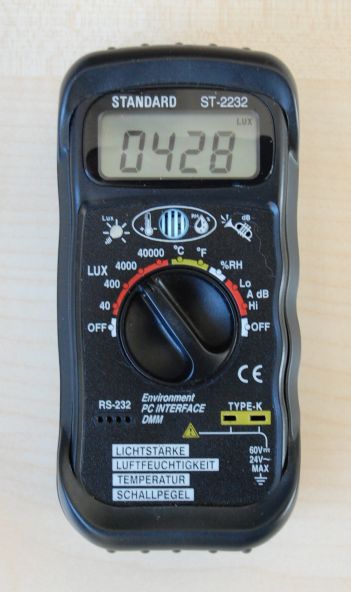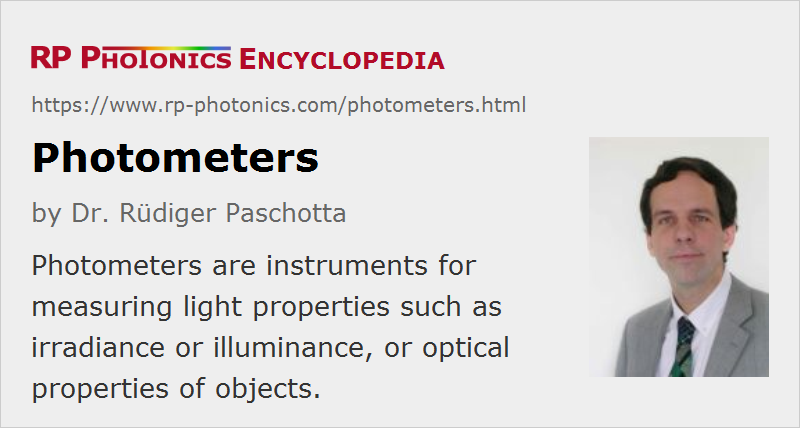Photometers
Definition: instruments for measuring light properties such as irradiance or illuminance, or optical properties of objects
More general terms: optical metrology instruments, photometry instruments
German: Photometer, Fotometer
Categories: photonic devices, light detection and characterization, optical metrology
How to cite the article; suggest additional literature
Author: Dr. Rüdiger Paschotta
The term photometer is used for a range of instruments with which one can measure certain properties of light, all related either to optical energies or to perceived brightness, or to related properties of objects.
Photometers for Radiometry
In the context of radiometry, one deals with physical properties of light or other kinds of electromagnetic radiation – independent of their visibility for the human eye. This implies that radiometric photometers can be applied not only to visible light, but also to infrared and ultraviolet light. Typical quantities of interest, which are measured with different kinds of photometers, are:
- the irradiance in SI units of W/m2, which in the context of laser technology is usually called optical intensity, and
- the radiant flux, which is otherwise called optical power and has units of watts.
For a given optical wavelength, the radiant flux from a source or an irradiance may e.g. be measured simply with a calibrated silicon photodiode. In case of the total radiant flux, all incident light should be within the active area of the photodetector. For measuring an irradiance, the active area of the detector should be placed within a region of approximately uniform irradiance.
For broadband light sources, it is important to have a flat spectral response, i.e., a constant responsivity over the relevant wavelength range. If a photodetector does not naturally have such a flat spectral response, it may be equipped with a suitable optical filter. The resulting approximately flat responsivity will then of course be lower than that of the bare photodetector.
Further, there are photometers for measuring optical properties of objects such as their transmittance, their reflectance or the degree of light scattering. For example, the fractional light throughput of some partially transparent object may be measured by comparing the transmitted intensities with and without the object (e.g., some liquid solution in a cuvette) inserted. Using the Beer–Lambert law, one can then e.g. measure the concentration of an absorbing substance in liquid samples.
Photometers for Photometry

Photometry deals with the perceived brightness of light. Typical quantities of interest are:
- the total luminous flux, which is e.g. sent out by a light source, specified in units of lumens (lm),
- the illuminance, which is the luminous flux incident on a surface per unit area, specified with the unit lux (lx) or lm/m2 (lumen per square meter), and
- the luminous intensity, which is the luminous flux per solid angle.
These quantities are related to radiant flux, irradiance and radiant intensity, but the contributions of different wavelength components are weighted with a luminosity function which takes into account the wavelength-dependent sensitivity of the human eye.
As in radiometry, photometric measurements on broadband light require an appropriate wavelength dependence of the responsivity of a photodetector. In this case, however, the responsivity should not be constant, but rather reflect the luminosity function of the human eye. That can again be achieved by equipping a photodetector with a suitable optical filter.
A common application of photometers is the measurement of the illuminance at work places. For example, it is recommended to have roughly 500 lx on office desks, e.g. when working with documents. For comparison, full sunlight corresponds to roughly 100,000 lx.
Another application is the measurement of the total luminous flux emitted by a light source. For a laser beam, this is simple, because the total emitted light flux can easily be sent to a photodetector, e.g. in the form of a power meter. For light sources radiating in all directions, but not uniformly, one may require an integrating sphere photometer. For light sources with uniform emission in all directions, the total luminous flux can simply be calculated as the product of the illuminance, measured in some distance d from the source, and the area 4 π d2.
Spectrally Resolved Measurements
Spectrophotometry denotes methods for spectrally resolved measurements. Spectrophotometers are instruments for measuring wavelength-dependent reflection or transmission properties of objects or substances. Also, there are spectrometers for measuring optical spectra of light sources.
If only color data are required, but not full spectral data, one can use some type of colorimeter.
Suppliers
The RP Photonics Buyer's Guide contains 15 suppliers for photometers.
Questions and Comments from Users
Here you can submit questions and comments. As far as they get accepted by the author, they will appear above this paragraph together with the author’s answer. The author will decide on acceptance based on certain criteria. Essentially, the issue must be of sufficiently broad interest.
Please do not enter personal data here; we would otherwise delete it soon. (See also our privacy declaration.) If you wish to receive personal feedback or consultancy from the author, please contact him e.g. via e-mail.
By submitting the information, you give your consent to the potential publication of your inputs on our website according to our rules. (If you later retract your consent, we will delete those inputs.) As your inputs are first reviewed by the author, they may be published with some delay.
See also: irradiance, illuminance, radiant flux, luminous flux, spectrophotometers, colorimeters, photodetectors
and other articles in the categories photonic devices, light detection and characterization, optical metrology
 |



If you like this page, please share the link with your friends and colleagues, e.g. via social media:
These sharing buttons are implemented in a privacy-friendly way!